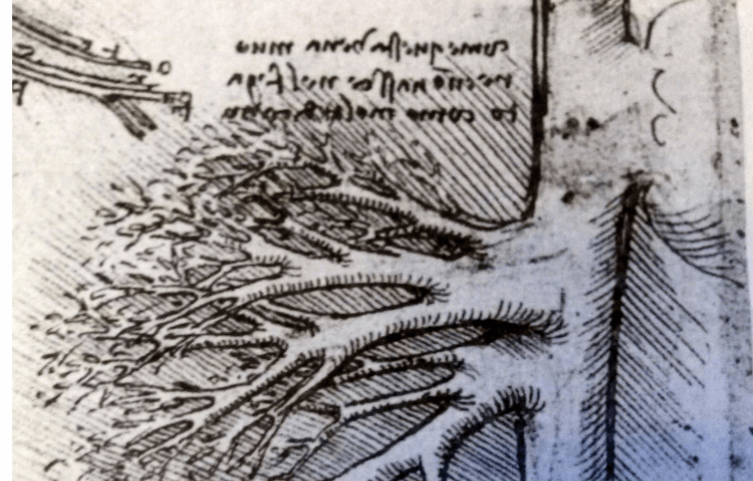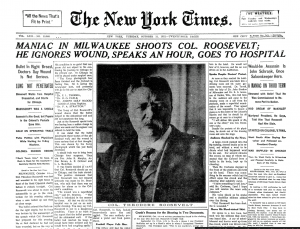In the year 1300, Pope Boniface VIII issued a papal decree, De Sepulturis, which outlawed various methods of lightening the bodies of the diseased for the ease of transport. These methods–common among the Crusaders in the Near East–included the removal of flesh by boiling as well as dismemberment, which also allowed for bodies to be stored in more compact containers. For years after, De Sepulturis was misinterpreted to include the condemnation of anatomical dissection, and for years the study of anatomy would suffer from this misconception. Over time, however, anatomical dissections regained popularity and became important not only to scientists of the body, but also to artists like Michelangelo and Leonardo Da Vinci. However, even into the 1500’s, anatomical sketches were considered distractions unworthy of publication in anatomy textbooks.1

Leonardo Da Vinci, the famous Italian polymath most commonly known today for his painting Mona Lisa, was not renowned for his anatomical diagrams in his time; but unlike his artist peers, his illustrations of the human structure went far beyond the superficial arteries and musculature. While his diagrams do not indicate formal training or even first-hand experience at dissection, Da Vinci began sketching the human anatomy at four different perspectives, simulating a three-dimensional model. Furthermore, Da Vinci sketched the bodily organs, and even wrote about their anatomical functions. It seems that it was Da Vinci’s unquenchable thirst for knowledge and inquiry that drove him to observe deeper than what most deemed necessary. This was characteristic of Leonardo from a young age. Indeed, in 1478, when Leonardo began his career in Florence under the Compagnia de San Luca, he was just sixteen. His early loves for mathematics and mechanics were maintained throughout his life and consistently influenced his vision of the world.4;

Vision was a key aspect to human knowledge to Da Vinci. Being a man of many talents and interests, Da Vinci was drawn to many occupations, and in 1478, after recommending himself to the Duke of Milan, he was made a royal appointee to the duke, Lodovico Sforza, as chief military engineer. In his letter of self-recommendation, Da Vinci referred to himself not only as an artist, but also as a mathematician, architect, and engineer. One of Da Vinci’s first tasks in Milan was to supervise the construction of the Cathedral at Pavia, which would become one of the largest cathedrals in the world. However, it is reported that Da Vinci became so immersed in the theoretical aspects of the physical laws and mechanics involved in the construction of the cathedral that his subordinate had to assume leadership on the practical matters of construction. During this time, Da Vinci also began a practice that has allowed historians and enthusiasts to obtain much deeper insight into the course of Da Vinci’s intellectual studies; like many intellectuals of the Renaissance, Da Vinci began cataloging and recording his studies in notebooks. Many of the anatomical sketches that still survive today were contained in such notebooks. Regardless of his official position as chief military engineer, however, Da Vinci’s primary modes of creation were artistic. Indeed, it was in Milan that Da Vinci finished the paintings Madonna of the Rocks, and The Last Supper; both are masterpieces of human expression and artistic style and technique.5
In 1500, Da Vinci left Milan and continued to paint. He spent several years as a vagabond and finished few paintings during these years, although the famous Mona Lisa was among those left unfinished around the year 1503. At the age of sixty-three, he was appointed to the company of the king of France, near Ambroise, where his chief duty was to keep good company to the king. Leonardo spent the last ten years of his life continuing his research in the realm of the physical sciences, and died on May 2, 1519.6
- Leonardo da Vinci, Leonardo Da Vinci on the Human Body: The Anatomical, Physiological, and Embryological Drawings of Leonardo Da Vinci, eds. Charles Donald O’Malley and John Bertrand de Cusance Morant Saunders (New York: H. Schuman, 1952), 13. ↵
- Leonardo da Vinci, Leonardo Da Vinci on the Human Body: The Anatomical, Physiological, and Embryological Drawings of Leonardo Da Vinci, eds. Charles Donald O’Malley and John Bertrand de Cusance Morant Saunders (New York: H. Schuman, 1952), 131. ↵
- Leonardo da Vinci, Leonardo Da Vinci on the Human Body: The Anatomical, Physiological, and Embryological Drawings of Leonardo Da Vinci, eds. Charles Donald O’Malley and John Bertrand de Cusance Morant Saunders (New York: H. Schuman, 1952), 14-16. ↵
- Leonardo da Vinci, Leonardo Da Vinci on the Human Body: The Anatomical, Physiological, and Embryological Drawings of Leonardo Da Vinci, eds. Charles Donald O’Malley and John Bertrand de Cusance Morant Saunders (New York: H. Schuman, 1952), 14-19 ↵
- Leonardo da Vinci, Leonardo Da Vinci on the Human Body: The Anatomical, Physiological, and Embryological Drawings of Leonardo Da Vinci, eds. Charles Donald O’Malley and John Bertrand de Cusance Morant Saunders (New York: H. Schuman, 1952), 18-21; Toby Lester, Da Vinci’s Ghost : Genius, Obsession, and How Leonardo Created the World in His Own Image (New York : Free Press, 2012), 117-121; Salem Press Biographical Encyclopedia, 2016, s.v. “Leonardo Da Vinci,” by James Livingston. ↵
- Salem Press Biographical Encyclopedia, 2016, s.v. “Leonardo Da Vinci,” by James Livingston. ↵



90 comments
Andrew Rodriguez
Leonardo da Vinci, was one of the most advance thinking people in history. Vast contributions to human knowledge to grow, his skills were unlimited. As a engineer he was fascinating in his designs of the early helicopters. This article showcased his thirst for knowledge, it was well research. I did not know about the pope law that he passed. I had no idea that da Vinci, was in the medical area I knew that he was a very knowledgeable person. This article was very enlightening.
Clarissa Bustamante
The research behind this articled was well done. It gave me a different view on Da Vinci’s art work and drawings of the human anatomy. I was not aware of all of the different art work Da Vinci produced, I only thought of the Mona Lisa. I was also interested that he started his work at the age of sixteen. This was a very well written article.
Tara Sellers
I never knew Leonardo Da Vinci was anything other than an artist. It surprises me that he was into mathematics and anatomy. However, it does make sense since his drawings look three-dimensional. You would have to be able to visualize the angles and know the human body for something to look three-dimensional. This article was very interesting and informative. I like how it gave background of the time and then introduced him.
Cameron Ramirez
Many people know about the many achievements of the great intellectual Leonardo Da Vinci, but few like myself knew that he was very interested in the study of anatomy. The sketch of the artificial vascular system made by Da Vinci is fascinating and well drawn which is good that you added it to your article. It’s amazing that we can still look to his manuscripts and read what Da Vinci had been curious about. Overall great article and it was concise and articulate.
Alondra Aviles
Today, Da Vinci proves to be one of the most influential anatomical/medical artist. Not many believed in his craft considering his age but yet he proved himself in front of many audiences. Although Mona Lisa was his iconic piece, but many fail to take into consideration the major contribution he made to the medical field. His perseverance to continue as an artist despite the minimal outlook was admirable. Proves his intelligence and stubbornness completely overtook his career. The article was very well written and very informative; it included an abundance of facts that I was not aware, much like his early career as a teenager.
Rafael Azuaje
Articles like this are as important now as they have ever been. When an individual is so gifted in different areas it is more likely they will be guided to an area other than the arts. I see it as a testament to the importance of the arts that Da Vinci chose to spend so much of his valuable time on artistic pursuits. He probably could have been a very wealthy man had he chose to.
Sebastian Castro Ramos
Some months ago I had the opportunity to see many photographs of these anatomical drawings of DaVinci and it was impressive how detailed and accurate it was compared to modern anatomical drawings. Definitely DaVinci fits the definition of a Renaissance Man because of his many talents in mathematics, architecture, art, anatomy and engineering. Great article, it is very informative and gives many details about DaVinci.
Nahim Rancharan
Leonardo da Vinci is without a doubt one of the greatest thinkers ever and this article perfectly captures the genius that was portrayed in each and every piece of his work. I knew about Leonardo Da Vinci and about some of his famous works such as the Mona Lisa and the Vitruvian man, but I had no idea of his other pieces that focused on the sciences and particularly that of human anatomy. It was interesting not only to read the article, but also to see samples of his work like that of the vascular systems in the arm. Additionally, it was interesting to see how influential the papacy was during that time as well as an interesting history with Leonardo’s brief work with Duke of Milan. This article was great at capturing how flexible and Leonardo Da Vinci truly was, which made him much more than an artist, which is why he is popularly remembered to this day. Overall, great article.
Anayeli Prieto
This is a really interesting article. Leonardo da Vinci is one of the most well-known painters and artists and lots of his paintings have hidden messages that people intend to discover. This article reminds me of the film the da Vinci code that gave a little bit of hidden information from the Monalisa painting and it made us wonder more about the historic events while he painted the Monalisa and other famous paintings. It was interesting to know what his thoughts were on the current events and how he intended to interpret them through his art.
Teresa Valdez
This article married the view of anatomical drawings and Da Vinci very well. The background information on De Sepulturis in particular was very interesting. From there, the transition between this information and the the section introducing da Vinci and his work very smooth. It is very understandable why it took so long to be acceptable to study the human body. I found it very interesting that da Vinci drew the body from so many different perspective. I would think that this would make it text book worthy.